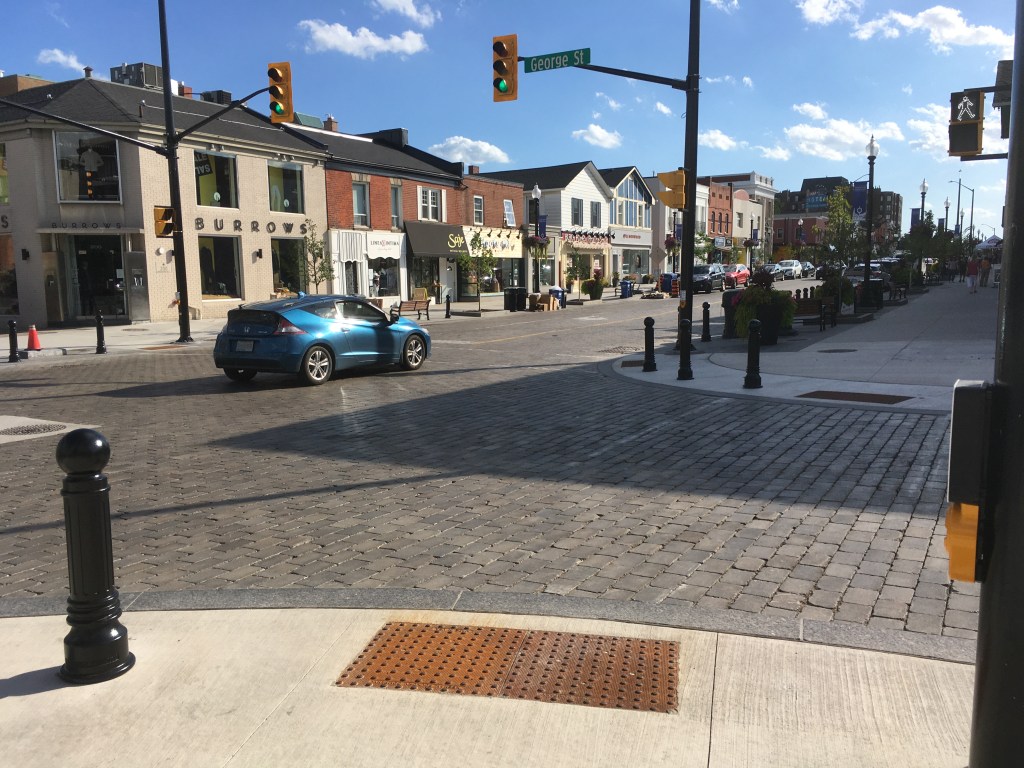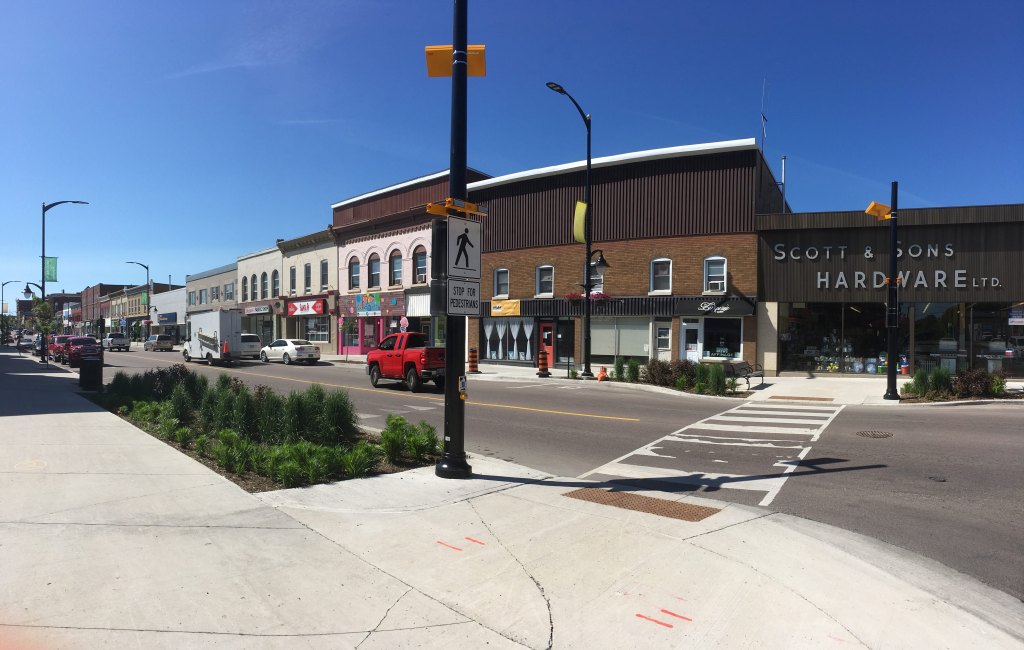Streets are not just infrastructure for moving people; they are places in and of themselves.
What – and who – are streets for? The answers to this question will vary wildly based on who you ask. While the users and designs of streets have changed over the years, the main functions of streets have not. Streets exist for three key purposes: to provide access to and from origins and destinations, facilitate movement, and provide public space.
#1: Access
Without places to actually go (origins and destinations), streets would be mostly useless. Thus, the first critical function of streets is to provide access. On a residential street, access is provided between homes (origins) and the street network. On a commercial street, access is provided to businesses. Street features that facilitate access include parking, driveways, front doors, and transit stops.

The way in which access is provided establishes which modes are prioritized. A commercial street with frequent driveways to large parking lots and setback buildings provides excellent access for motorists, but poor access for pedestrians. A street with a subway station nearby or frequent bus service will provide increased access for people using transit. A street with plentiful bike racks provides excellent access for cyclists.

#2: Movement
People use streets and street networks to move around their communities. They’re often compared to the circulatory system of a city. “Arterial” streets are intended to move lots of people over longer distances, while “local” streets serve the initial or final leg of trips only.
Movement, of course, comes in many forms – walking (or “rolling”), cycling, public transit, and driving – and different streets can serve different movement objectives based on the dominant modes. Freeways prioritize the movement of vehicles while prohibiting walking and cycling. “Bicycle boulevards” create priority routes for cycling on streets that carry only local motor vehicle traffic. Toronto’s King Streetcar priority project is an example of deprioritizing a route for cars in order to increase priority for transit. Multi-use trails function as streets that exclusively serve pedestrians and cyclists with a route that is separated from traffic.
Serving the movement function for all modes with a single corridor is challenging. If the road is wide and carries a lot of traffic, pedestrians and cyclists will be disadvantaged with noise, emissions, potential conflicts with vehicles, and long crossing distances. Narrower streets with wide sidewalks may be more pleasant for pedestrians but could become significantly congested if intended to serve a movement function for vehicles. Quite often the best route for cars is not the best route for people walking or riding a bike, and thoughtful street network design can disentangle these uses.
#3: Public Realm
The third and final function of streets is the least-mentioned and most abstract. “Public realm” captures everything that happens on a street unrelated to going somewhere. It is the essence of simply existing on a street. Quite literally, stopping to smell the roses. Or striking up a conversation with a neighbour, or playing in the street with your children, or dining on a street patio with a friend, or going for a leisurely bike ride. Protests, one of the most fundamental components of democracy, are an example of the public realm function.

It is tempting to discount public realm as a legitimate street purpose, as movement and access can be clearly tied to economic value (getting people to work, supporting business, etc.). In fact, many travel demand surveys (which help determine new investments in transportation infrastructure) wouldn’t even measure this type of street use, so many cities have limited data on this.
But public realm is just as essential of a function as movement and access. Public realm is the reason many people enjoy living in urban areas, and why “the suburbs” are often seen as boring and monotonous. Public realm is why people like vacationing to European cities, and visiting “cute” old towns.
The public realm function is reinforced with urban design and streetscaping such as trees, benches, wide sidewalks, rain/sun shelters, scenic views, attractive storefronts, etc. Good public realm design makes people want to go to that street. It disrupts the movement function as people are tempted to walk more slowly, and supports the access function as people are more likely to patron multiple businesses or “window shop”.

The key elements to a street with a strong public realm have been well researched and documented; the video below from City Beautiful summarizes many of these.
There are also detractors of public realm. Higher motor vehicle volumes and speeds create more noise and pollution, making it unpleasant to linger too long. Empty lots or plain walls make streets uninteresting. Sidewalks that are too narrow will make it very uncomfortable to stop and chat, or even to walk side-by-side. Frequent interactions with motorists at intersections and driveways force people to always be on the alert for traffic, making it much harder to relax.
Streets for All?
People do not equally benefit from the public realm function of streets. Black people are more likely to be regarded as suspicious or intimidating. People experiencing homelessness may be more likely to be harassed by police. Women can be a target for harassment from men. All of these people have an equal right to the street, but have their access reduced as a result of racism, classism, and sexism. These are complex social issues that must be addressed. Amina Yasin, an urban planner in the Metro Vancouver area, offers suggestions for addressing this in her piece in The Tyee, Whose Streets? Black Streets.
I invite all of us in urbanism fields, especially those who espouse “cities for all” and “open streets for people of all ages, abilities and backgrounds,” to consider why Black people are harassed and dying in public spaces while jogging, riding their bicycles, walking, playing, bird watching in the park, having a barbeque, just existing in public space, or even — yes — driving their cars.
quote from Whose Streets? Black Streets, by Amina Yasin
Movement, access, and public ream complement and contrast each other in complex ways that often have competing objectives. A single street can not be all things for all modes and it is for this reason that street design must be multidisciplinary – traffic engineers, urban planners, and urban designers must all work together to decide which streets prioritize which functions and modes. A historic main street is likely not a suitable candidate for widening for motor vehicles. Similarly, a busy car arterial might not be the best target for an expensive public realm project.
Consequences arise when incompatible functions are combined. Collisions may increase, transit ridership may suffer, or people may choose not to walk or cycle out of discomfort. A street that prioritizes movement for cars is not necessarily one that should prioritize movement for pedestrians and cyclists (and vice versa); there is value in separating these purposes onto different streets.
Finally, everyone has a right to simply exist on a street, and cities have a responsibility to support this right.
Bonus: Some Example Combinations
Below are a few examples of streets which combine different function and modal priorities. All can be done well or poorly – the devil is in the details.
Commercial Arterial
The “Commercial Arterial” is a common North American street that prioritizes both movement and access, mostly for motor vehicles. High speeds and frequent turns create lots of conflicts, especially for pedestrians and cyclists. Public realm is virtually absent.

Grand Boulevard
The “Grand Boulevard” attempts to combine quality public realm to a wide street intended for carrying a lot of traffic. These can be done well or poorly, depending on how fast the traffic is, and the quality of the public realm design.

Pedestrian Street
The “Pedestrian Street” amplifies access and public realm for people on foot at the expense of access and movement for motor vehicles.

Historic Main Street
The “Historic Main Street” exists in many cities and towns and has a strong public realm, because it often predates the invention of cars. Buildings are interesting and open onto the sidewalk, and motor vehicle volumes and speeds are typically low to moderate.

Suburban Arterial
The “Suburban Arterial” prioritizes movement for motor vehicles. There are minimal driveways fronting the street, and access is almost exclusively at signalized intersections which are spaced far apart. Sidewalks are set back, and crossings are infrequent. The wide “clear zones” on each side of the roadway that must be kept clear of obstructions, reducing opportunities for public realm enhancements.

Bicycle Boulevard
The “Bicycle Boulevard” prioritizes movement for people riding bikes while actively reducing the priority for motor vehicles. Speeds are limited to 30-40km/h and vehicles are forced to turn at many intersections.


